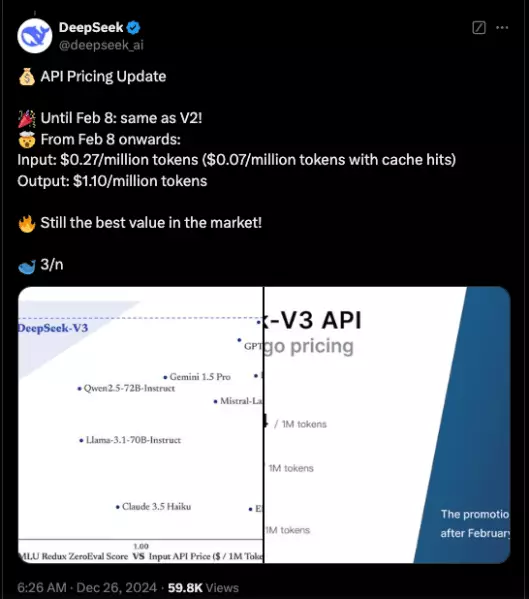In the ever-evolving realm of artificial intelligence, the introduction of DeepSeek-V3 marks a significant leap forward, both in capability and accessibility. Developed by a Chinese startup that emerged from the quantitative hedge fund High-Flyer Capital Management, DeepSeek has made a name for itself through its commitment to open-source technologies. The recent launch of its ultra-large model, DeepSeek-V3, with a staggering 671 billion parameters, serves as a powerful challenge to established AI giants by demonstrating that cutting-edge technology can emerge from less conventional sources.
DeepSeek-V3 employs a mixture-of-experts (MoE) architecture, activating only a fraction of its vast parameter set for each task. This innovative design is particularly noteworthy, as it optimizes the model’s performance while managing computational resources efficiently. By engaging 37 billion parameters per token out of the total 671 billion, the model effectively tailors its capabilities to the complexities of specific inputs, showcasing flexibility that can surpass traditional models which rely on their entirety for each operation.
The benchmarks released by DeepSeek highlight the model’s performance, indicating that it significantly outperforms notable counterparts such as Meta’s Llama 3.1 with 405 billion parameters. In impressive fashion, DeepSeek-V3 is not only closing the performance gap with closed-source models from leading companies like Anthropic and OpenAI, but it is also challenging the notion that larger models are strictly superior in delivering AI capabilities.
DeepSeek has introduced two pivotal innovations that further enhance the efficacy of DeepSeek-V3. Firstly, its auxiliary loss-free load-balancing strategy optimally distributes the computational load among the MoE parameters. This dynamic adjustment ensures that each expert is utilized efficiently, enhancing overall model performance without sacrificing quality.
Secondly, the multi-token prediction (MTP) capability is noteworthy for its potential to transform AI processing speeds. By enabling the model to predict multiple tokens at once, DeepSeek-V3 can generate output at a remarkable rate of 60 tokens per second, significantly accelerating its response time. Such advancements are not merely incremental; they reflect a strategic shift towards more effective AI training methodologies as they maximize computational resources and improve user experience.
The training regimen for DeepSeek-V3 involved an impressive dataset of 14.8 trillion high-quality tokens, showcasing the company’s commitment to building a robust and versatile AI model. The two-phase context length extension — initially increasing to 32,000 tokens and then escalating to an impressive 128,000 tokens — speaks to the painstaking attention given to maximizing context understanding and response relevance.
Moreover, DeepSeek’s approach to training was not only comprehensive but also economically savvy. Utilizing innovative techniques such as FP8 mixed precision training and the DualPipe algorithm, the entire process was completed in approximately 2,788,000 GPU hours, amounting to about $5.57 million in costs. This figure stands in stark contrast to the hundreds of millions often incurred in training comparable large language models.
The performance of DeepSeek-V3 has established it as a formidable contender in the open-source AI space, excelling particularly in Chinese and mathematical benchmarks, where it achieved unprecedented scores. Its success in the Math-500 test illustrates a deep understanding of quantitative tasks, and its ability to consistently outperform peers like Qwen 2.5 solidifies its position as a leader in this domain.
However, while DeepSeek-V3 has made significant strides, it does contend with challenges from models such as Anthropic’s Claude 3.5, which has outperformed it in some specific benchmarks. This indicates that while open-source solutions are closing the performance gap, there remains a competitive edge in certain proprietary models, underscoring the ongoing race for AI supremacy.
The arrival of DeepSeek-V3 heralds a new era in the open-source AI landscape, as it offers diverse performance that is increasingly comparable to closed-source offerings. By promoting a broader spectrum of AI solutions, DeepSeek fosters an environment where enterprises can make informed choices tailored to their specific needs rather than relying solely on a dominant player. The shift towards democratization of AI technology promises to reshape how organizations engage with and harness AI.
With its code available via GitHub and the model accessible through DeepSeek Chat and commercial applications, the pathway to harnessing sophisticated AI capabilities is becoming clearer than ever. As the industry witnesses this evolution, it remains evident that the quest for artificial general intelligence (AGI) is not merely a theoretical ambition, but a tangible reality shaped by innovations like DeepSeek-V3.


Leave a Reply